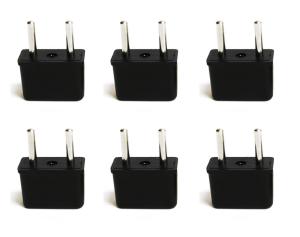Almost all gadgets these days are auto-switching, which means that the electric guts of most laptops, tablets, mobile phones and media players can automatically switch to a different electrical system. If you were going to Europe, for instance, you wouldn’t need to bring a voltage converter, just some plug adapters like these:

When you get to Europe, you just insert your American plug into one end of the adapter, then plug the adapter into the wall outlet, and you’re done: your device handles the rest.
You know what would be even better, though? How about a European power strip with universal plugs!

The business-end of this power strip is an EU plug, but the outlets on the strip can accept several types of plug: 2 or 3 prong US plugs, the UK and Ireland’s comically large plugs, native European plugs and more. It also has two USB ports providing a total of 2.1 amps.
I bought one of these for a recent European vacation, and couldn’t be happier with it. Our hotel room in Brussels only had one available outlet, so the missus and I were able to charge our many devices without a problem. We rented a private apartment in Paris, and the bedroom outlets were in inconvenient locations; I put the power strip in the living room, and the four of us took turns charging things off it. Very handy indeed:

Here’s a cellphone pic of the strip in action, charging (from left to right), an Anker 5-port USB charger, a European cell phone with native charger, my Asus tablet, and my iPod Nano via USB.
The iFer power strip is available from Amazon for around $15.99.



